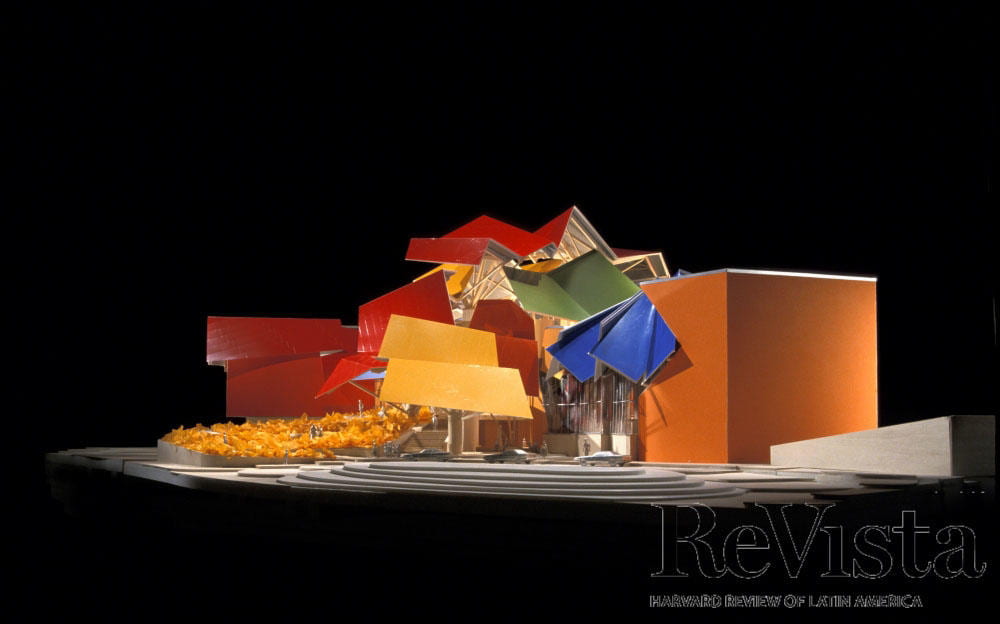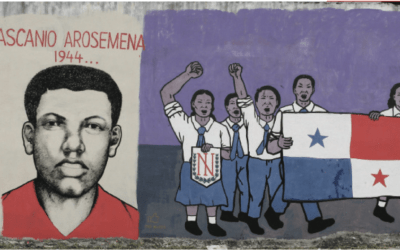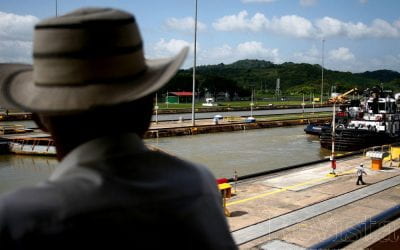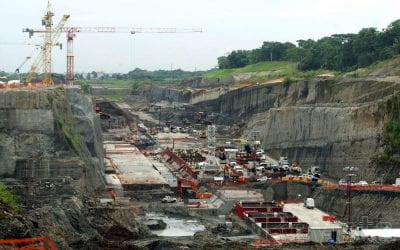Building the Biomuseo
Frank Gehry’s First Building in Latin America
Panama City, the first city in the Western Hemisphere to be founded on the Pacific Coast, is today a vibrant, busy tropical metropolis. Panama City is a place of contrasts. Its towering skyscrapers—including the tallest in Latin America—line the Bay of Panama, a little over a mile from the tropical rainforests of our National Parks. While new towers are constantly rising on the eastern reaches of the waterfont—Paitilla and Punta Pacífica—something far more compelling is taking shape at the west end of the city. The Amador Peninsula, tucked between the Old Quarter and the Panama Canal, is now the home of the Biomuseo, a new natural history museum that tells the story of how Panamá changed the world. This extraordinary tale will be housed in an extraordinary new building designed by Frank Gehry.
Although Gehry had visited Panamá many times—his wife, Berta, is Panamanian—he had never designed a project in Latin America. His acclaimed Guggenheim Museum Bilbao, in Spain, opened to the public in October 1997. The following years saw the city of Bilbao morph from an obscure industrial city into a world-famous cultural destination, with Gehry’s Guggenheim identified as the main catalyst of this change. This success story became a well-documented case study to show the benefits of high-visibility cultural buildings, and many governments—including Panamá’s—became interested in replicating this “Bilbao effect.” At the Bilbao opening were Rodrigo Eisenmann and his wife Chabelita, a cousin of Berta Gehry’s, and they approached Gehry with a suggestion to design a museum for Panama City. After returning to Panamá, Eisenmann, his cousin Roberto Eisenmann, and a number of Panamanians established the nonprofit foundation, Fundación Amador, and began lobbying for the project; in 2001, they secured government funds to build the Biomuseo.
The scientific content of the museum, the exhibits that would tell the story, and the building that would house the exhibits were developed in a series of workshops in Panamá and the United States, where Gehry Partners’ team of architects was joined by scientists from the University of Panama and the Smithsonian Tropical Research Institute, exhibit designers from Bruce Mau Design, and landscape designer Edwina von Gal. The outcome of this iterative, collaborative design process is a museum where architecture, landscape and exhibitions blend to become a synthetic whole. In the Biomuseo, form and content will be understood and experienced by a visitor as one intertwined narrative.
The design of the building and exhibits were guided by three principles:
1. To Educate: Biomuseo is, first, a place for learning. Through the museum, Panamá gains a profound opportunity to imprint its collective scientific understanding upon its cultural and natural landscapes. The exhibition design seeks to create museum experiences that encourage and permit rich, varied and accessible opportunities to understand what natural science makes possible.
2. To Network: Panamá is the museum, the Biomuseo is the interchange. In every exhibit area, and with every message, the purpose is to focus attention, energy and intelligence out and across the whole country. The Biomuseo is a network hub, a place where visitors can orient themselves to the wealth of natural and cultural assets across Panamá.
3. To Declare: The three primary goals of the project are interdependent. No two can succeed in the long term without the third. This is most critically the case for its declarative purposes. The building, its exhibitions, its park setting and its operating program must combine to produce a very special celebratory effect. The project must be a landmark, broadcasting an image of the best of Panamá far beyond its Amador setting on the city’s waterfront. It must express a new sensibility, a new valuation of Panamá’s ancestral layers and a new national spirit.
The history of the Isthmus of Panamá, a so-called “bridge of life” between continents, peoples and ideas, is a story of connections made and connections broken. This story is told in the Biomuseo’s eight galleries, each of which embodies one chapter of this tale. A visit to the Biomuseo is designed as a journey, with spaces structured to accommodate different group sizes and levels of engagement. Each gallery is anchored by a “Device of Wonder”: a large-scale, visually engaging element that is the artistic representation of the basic scientific idea of the space. The Devices of Wonder turn the visitor into a more active participant in the search for answers: they pull the visitor towards information, rather than pushing information at the visitor.
The visit begins at the Gallery of Biodiversity, a sloping hallway that introduces the concepts developed further on: what is biodiversity, what are its benefits, and what is happening to it today. From there we pass to Panamarama, a triple-height projection space with screens all around that presents an audiovisual journey through Panamá’s diverse natural landscapes. The third gallery is called Building the Bridge, where we learn about the geological processes that, over millions of years, caused the Isthmus of Panamá to rise from the bottom of the ocean.
Three million years ago, Panamá first connected North America and South America and allowed two very different faunas to meet. Worlds Collide, the fourth gallery, represents the Great American Biotic Interchange, with 97 full-size sculptures of animals that crossed the Isthmus in both directions. These range in size from a shrew and a frog that measure a few inches to the 8-foot-tall Cuvier’s mastodon and the 13-foot Hermit Ground Sloth.
Among the most recent migrants to use this land bridge to cross from North America into South America were humans. Our gallery The Human Path tells the story of human presence in Panamá, from the first Paleoindians who arrived 13,000 years ago to the present. From there we move to Oceans Divided, which is the oceanic counterpart to the Building the Bridge story. When the two halves of the continent came together, Panamá joined two land masses and separated what used to be a single tropical ocean into two. Today, the Caribbean and the Pacific are very different, and in this gallery we’ll learn how Panamá created these differences. The seventh gallery is The Living Web, which presents the tropical rainforest as the environment where biodiversity reaches its apex. A giant sculpture—part animal, part plant—fills the space and shows how all living organisms are connected by a web of interdependent relationships, including symbiosis, predation and parasitism. The final gallery, Panamá Is the Museum, reminds the visitor that everything they’ve seen is a symbol, and that the real museum is outside: the country itself.
The Biomuseo sits on a 7.5-acre site at the tip of Amador Peninsula, at the mouth of the Panama Canal. The museum building occupies the middle of a botanical park that will be free to the public, becoming a contribution that the Biomuseo makes to Panama City’s public park system. The park is organized in thematic areas that expand on the topics presented by the galleries and complements them with larger, living exhibits, including Plants from the North and South, Ethnobotany, and the Butterfly Forest. These zones are anchored by a shaded pavilion that provides a place to sit down and study the surroundings, but the space also includes giant planters filled with flowers, a frog pond and a grotto overgrown with epiphytes and mosses.
Panamá builds a lot, and it builds fast, but constructing a world-class building has been a big challenge. The Biomuseo is by far the most complicated project ever built in the region, with a set of construction drawings that is reaching 20,000 sheets, and it requires materials and construction systems that are not usually employed in the country. The project has thus served to train hundreds of local contractors and dozens of local construction companies. The going has been tough, facing fundraising and construction problems, but local support has grown steadily, especially in the last few years. In December 2009 we launched our Friends of Biomuseo program, and to this date we have almost 700 members: the largest membership program of all the museums in Panama City. After twelve years of hard work, we are fast approaching the finish line: Biomuseo will open to the public this year.
We are particularly interested in establishing a close connection between the Biomuseo and the Panamanian school system. Our plan is ambitious: we want to host 40,000 schoolchildren every year through our educational programs, which aim to strengthen the links between Panamanian museums and schools. To accomplish this goal, our education department has spent more than a year working with the Ministry of Education on teacher workshops and materials to assure that the student visits to the museum are closely connected to the national standards. The visits will focus on the science that produced the content, promoting critical thinking and awareness of our cultural and natural heritage.
The Biomuseo celebrates Panamá for it biological and cultural diversity, and a celebration is definitely due. We are busy wrapping up construction and installation, as well as planning a series of opening ceremonies that will span over a whole month. So, if you’re thinking of visiting Panamá, 2013 is definitely a good time to come. Come to the Biomuseo, learn how Panamá changed the world three million years ago, and how you can change it today.
Spring 2013, Volume XII, Number 3
Darién Montañez is the Coordinator of Exhibit Production for the Biomuseo.
Related Articles
A Tale of Two Flags
A Tale of Two Flags The Last Hurdle When in 1995 President Ernesto Pérez Balladares appointed me to head the commission responsible for the transition of the Panama Canal from U.S. to Panamanian hands, it never crossed my mind that yet another negotiation—unexpected...
Who Remembers Panamá?
There was a time, many decades ago, when the Isthmian country of Panamá—dividing the Americas—made near daily headlines from Canada to Argentina…
The Story That Panamá Decided to Write
A few days prior to the date set for the transfer of the Panama Canal from the United States to Panamá, a reporter from a U.S. news network asked me, “Mr…





